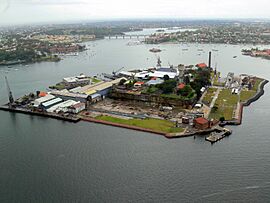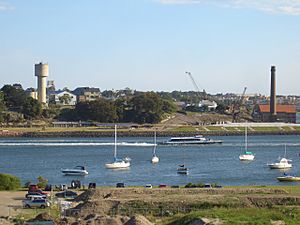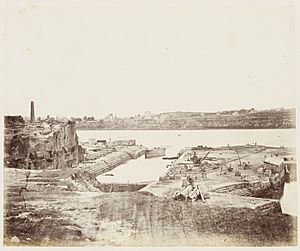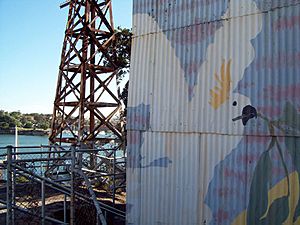Cockatoo Island facts for kids
Quick facts for kids Cockatoo IslandSydney, New South Wales |
|||||||||||||||
|---|---|---|---|---|---|---|---|---|---|---|---|---|---|---|---|
| Nearest town or city | Woolwich | ||||||||||||||
| Postcode(s) | 2110 | ||||||||||||||
| Area | 0.179 km2 (0.1 sq mi) | ||||||||||||||
| Location | 4 km (2 mi) northwest of CBD | ||||||||||||||
| Managing authorities | Sydney Harbour Federation Trust | ||||||||||||||
| Website | Cockatoo Island | ||||||||||||||
|
|||||||||||||||
| UNESCO World Heritage Site | |
|---|---|
 |
|
| Part of | Australian Convict Sites |
| Criteria | Cultural: iv, vi |
| Inscription | 2010 (34th Session) |



Cockatoo Island Wareamah is a special island in Sydney Harbour, Australia. It sits where the Parramatta River and Lane Cove River meet. This island is so important that it's a UNESCO World Heritage Site.
Long ago, the island was covered in trees and rose about 18 meters above the water. It was about 12.9 hectares in size. Over time, it grew to 17.9 hectares and most of its trees were cleared. The Indigenous Australians called it Wa-rea-mah. They might have used it for fishing before Europeans arrived.
From 1839 to 1869, Cockatoo Island was a prison for convicts. It was mainly for prisoners who had committed more crimes after arriving in Australia.
The island also became one of Australia's biggest shipyards. It operated from 1857 to 1991. Convicts even helped build the first of its two dry docks. The island is famous for showing how a large shipyard worked for a long time. It has many records of shipbuilding in Australia.
In 2010, UNESCO named Cockatoo Island a World Heritage Site. The Sydney Harbour Federation Trust has looked after the island since 2001.
Contents
What's Happening on Cockatoo Island Today?
The Sydney Harbour Federation Trust manages Cockatoo Island. They want to make it a popular spot in Sydney Harbour. They host cultural events and share its history.
Today, you can still see parts of the island's past. Its old prison buildings are now World Heritage listed. They are part of a group of 11 Australian Convict Sites.
Many large workshops and buildings were taken down after the shipyard closed in 1991. But some important structures like slipways and wharves remain.
In 2005, the Harbour Trust held the Cockatoo Island Festival. This event helped make the island a place for art and culture. Since then, many art shows and festivals have taken place there.
Camping and Stays on the Island
In 2008, the Harbour Trust opened a camp and glampsite on the island. About 20,000 campers visit each year. It's a great place to watch Sydney's famous New Year's Eve fireworks. In 2010, over 2000 campers watched the fireworks from the island. You can also stay in renovated houses and apartments with amazing views.
How to Get to Cockatoo Island
Sydney Ferries take visitors to Cockatoo Island. You can catch a ferry from Circular Quay or along the Parramatta River. The island is open every day, and there's no entry fee. You can picnic, barbecue, visit the cafe, or take a tour.
Fun Events and Art
Cockatoo Island has become a popular place for cultural events in Sydney.
- In 2008, it was a main location for the 16th Biennale of Sydney, an art festival. Over 80,000 people visited. In 2010, it attracted over 156,000 people.
- In 2009, the island hosted the Sydney Festival's "All Tomorrow's Parties" music festival. Nick Cave helped organize it, and over 11,000 people attended.
- The World's Funniest Island Comedy Festival was held there in 2009. It featured 200 comedy acts and drew over 8,000 visitors.
The island is also used for private events and filming. Parts of the movies Unbroken (film) and X-Men Origins: Wolverine were filmed there in 2008.
Cockatoo Island's Early History
Before Europeans arrived, Indigenous Australians used Cockatoo Island. In 1839, Governor Sir George Gipps chose it for a new prison. It was a convict prison from 1839 to 1869. Prisoners from Norfolk Island were sent there. They built barracks and silos to store grain for the colony. By 1842, about 140 tonnes of grain were stored on the island.
Later, stone from the island was used for building projects in Sydney. This included the seawall for Circular Quay. Between 1847 and 1857, convicts dug the Fitzroy Dock. This was Australia's first dry dock. They dug out about 1.5 million cubic feet of rock.
In 2009, archaeologists found convict punishment cells under the old cookhouse. These cells show us what life was like for prisoners on the island.
One famous prisoner was the Australian bushranger, Captain Thunderbolt. He escaped in 1863. Some stories say his wife swam to the island with tools to help him escape. Then they both swam back to the mainland.
From 1871 to 1913, the island was sometimes called Biloela. This was to avoid the bad reputation of its convict past.
Fitzroy Dry Dock
The Fitzroy Dock was designed by Gother Kerr Mann. Convicts built it between 1847 and 1857. Governor Charles Augustus FitzRoy laid its foundation stone in 1854. The dock was named after him. When finished in 1857, it was 316 feet long and 76 feet wide. The ship HMS Herald was the first to use it in December 1857. The dock was made longer between 1870 and 1880, reaching 643 feet.
Sutherland Dock
The Sutherland Dock was built between 1882 and 1890. Engineer Louis Samuel oversaw its construction. It was named after John Sutherland, a government official. This dock was big enough for ships weighing 20,000 tonnes. It was updated in 1913 and 1927 for Royal Australian Navy ships.
Industrial School and Prison
In 1864, the island was split into two parts. One part was for the NSW Department of Prisons. The other was for the Public Works Department, which expanded the dockyard. In 1869, the convicts moved to Darlinghurst Gaol. The prison then became an Industrial School for Girls and a Reformatory.
Cockatoo Island Shipyard
Shipbuilding started on Cockatoo Island in 1870. In 1913, the island became the Naval Dockyard for the Royal Australian Navy. Before World War I, five slipways were built or improved. Two of these are still on the island today.
The torpedo boat destroyer HMAS Warrego was the first naval ship launched here. It was built in the UK, taken apart, and then put back together on Cockatoo Island. During World War I, the dockyard built and fixed many ships. At its busiest during the war, about 4,000 men worked on the island.
In 1933, the island was leased to the Cockatoo Docks & Engineering Company. This lease was renewed several times.
In 1995, a group called "Friends of Cockatoo Island" helped save the island. They fought to protect it and other old Defence sites. Their efforts led to the creation of the Sydney Harbour Federation Trust. This Trust now protects many harbour sites, including Cockatoo Island.
Special Heritage Listings
In July 2010, Cockatoo Island became a UNESCO World Heritage Site. It was listed with ten other Australian sites related to convict transportation. These sites show the best examples of how convicts were transported and used to build colonies. Other sites in Sydney include Hyde Park Barracks and Old Government House.
Other parts of Cockatoo Island also have heritage listings:
- Cockatoo Island Industrial Conservation Area
- Prison Barracks Precinct
- Underground Grain Silos
- Biloela House precinct
- Fitzroy Dock
- Sutherland Dock
- Power House & Pump House
Events on Cockatoo Island
Since 2005, Cockatoo Island has hosted many big events. These include art festivals, music shows, and even motocross competitions.
| Festival name | Details and comments |
|---|---|
| Biennale of Sydney | In 2008, Cockatoo Island became a main place for this art festival. It attracted about 86,000 visitors. In 2010, it hosted the 17th Biennale, with 120 artworks and 157,000 visitors. The 18th Biennale in 2012 also used the island as its main venue. |
| Cockatoo Island Festival | In 2005, a three-day music and arts festival took place. It used old buildings for shows and shops. Over 20,000 people came to see 120 music acts and comedians. Ferries ran day and night for ticket holders. |
| Red Bull X-Fighters World Tour Finale | The final of this freestyle motocross competition was held on Cockatoo Island in October 2011 and 2012. |
| Sydney Festival | In 2009, Cockatoo Island hosted the "All Tomorrow's Parties" music festival. Nick Cave helped organize it. About 12,000 people attended this event. |
| World's Funniest Island Comedy Festival | In 2009, the island hosted this comedy festival. It ran for two days and attracted about 8,000 people. |
Planning for the Future
The Sydney Harbour Federation Trust took over Cockatoo Island in 2001. They planned to make it a public park. In 2003, they created a plan to bring the island back to life. This plan included bringing back maritime activities and sharing its history. It also aimed to create parklands and spaces for cultural events. The Harbour Trust updated its management plan for the island in 2010.
How to Get There
When the island was a working dockyard, ferries took workers to and from Circular Quay.
In April 2007, the ferry wharf reopened for a trial. This was when the island became a tourist spot. Now, Sydney Ferries run regular services. You can take a ferry from Circular Quay or along the Parramatta River. The wharf is served by First Fleet and RiverCat ferries.
See also
 In Spanish: Isla Cockatoo (Nueva Gales del Sur) para niños
In Spanish: Isla Cockatoo (Nueva Gales del Sur) para niños





